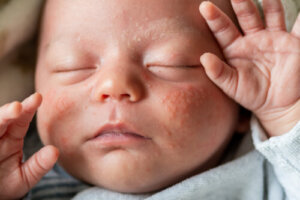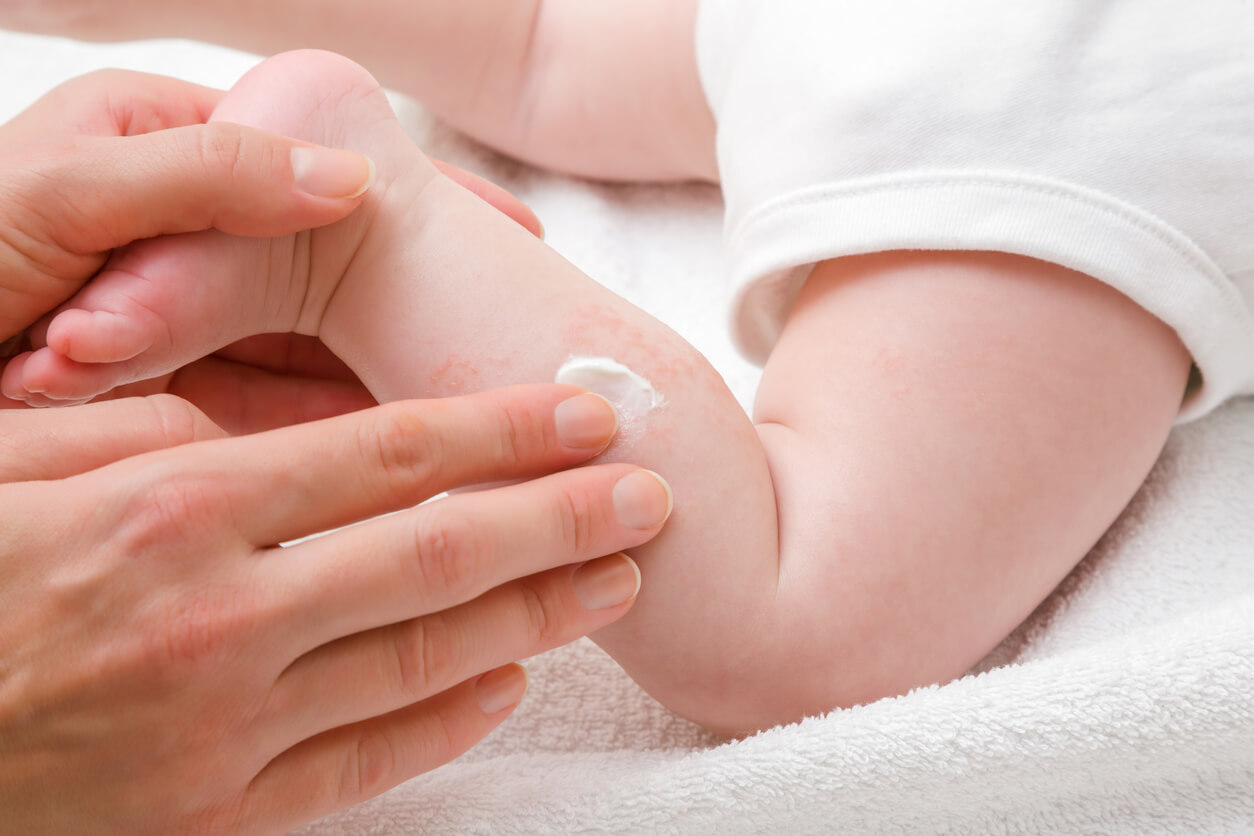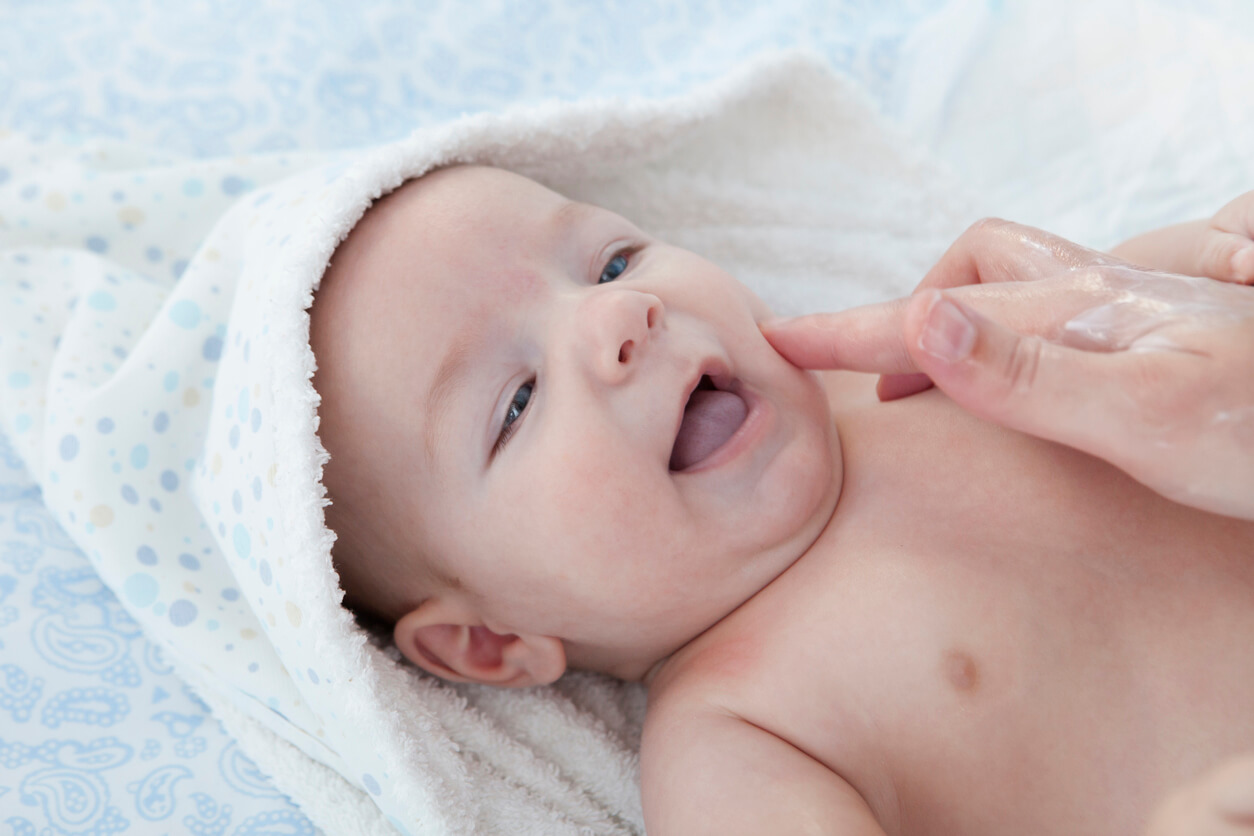My Baby Has Reactive Skin

Babies often have reactive skin due to their increased sensitivity and immaturity. In fact, heat or cold may be some of the triggers. Reactive or intolerant skin is characterized by redness and dryness of the skin surface leading to itching and scratching. It’s also a benign and non-contagious condition. If your baby has reactive skin, keep reading the article below.
What is reactive skin?
Reactive skin is described by the appearance of unpleasant sensations in response to stimuli that in everyday life don’t usually produce such perceptions. In addition, they can’t be explained by the characteristic lesions of any disease.
Some substances, products, or conditions can trigger rashes or dry skin in infants. Also, a child who has any of the following symptoms is more likely to have reactive skin:
- A skin reaction after a bath with soap.
- Skin changes after the application of a lotion caused by a component or fragrance.
- Skin alterations after dressing or covering with a blanket. In most cases, it’s caused by detergents or dyes.

What triggers reactive skin in babies?
Reactive skin is a chronic manifestation that’s increasingly seen in babies. It’s often triggered by environmental factors and the use of irritating products.
The condition occurs in periods of outbreaks and remissions, while the most affected region of the body is the face. In turn, it occurs more frequently in women and girls, or in very fair skin that’s exposed to sunburn.
Intolerant skin is more predisposed to external aggression and causes an exacerbated reaction to external agents that are usually well tolerated, such as the following:
- The sun
- Heat
- Pollution
- Cold
- Wind
- Air conditioning
Babies younger than 6 months should be kept away from ultraviolet rays, according to The American Academy of Pediatrics. However, sunscreen with an SPF of 50 can be applied to those older than 6 months to avoid excessive reactions to the sun.
Remember that the sweat glands of babies aren’t fully developed, so they’re also prone to heat rashes. However, this can be avoided by dressing them in light, loose-fitting clothing and accessories such as hats.
Normal manifestations of baby skin
Babies’ skin is more delicate and sensitive because it’s not fully developed. Therefore, there are rashes or skin surface reactions that are considered normal. According to Seattle Children’s Hospital, some of these rashes include the following:
- Milia skin rashes: These are tiny white bumps that appear on the face.
- Drooling eruptions: This is very common and observable at any time during infancy.
- Baby acne: This is common between the second and fourth week after birth.
- Erythema toxicum: This is a harmless rash characterized by red spots with small white centers that appears within two days after birth and disappears on its own, according to The American Osteopathic College of Dermatology.
You may be interested in: 10 Natural Remedies for Dry Skin in Babies
How to manage if your baby has reactive skin
The primary thing is to find out what’s triggering the skin reactions in infants. In cases where the cause is unknown, the following precautions can be taken:
- Avoid using detergents with dyes or fragrances.
- Use mild or syndet soaps during bathing and when sanitizing your baby.
- Always keep the diaper area dry and clean.
- Use specific products for sensitive skin.
- Apply emollients and moisturizers several times a day.

Recommendations for bath time
Newborn skin is sensitive and soft, so one of the essential indications is to keep the skin surface moisturized.
The application of an emollient cream is better absorbed after the bath, which shouldn’t be prolonged, but rather last between 3 and 5 minutes. In addition, the water should be lukewarm, at an ideal temperature so as not to aggravate the skin. Before putting on the diaper, the area should be dried correctly and gently to avoid subsequent dermatitis due to maceration or irritation. In fact, there are fragrance-free and hypoallergenic diapers for sensitive and delicate skin.
Babie and reactive skin
Our skin is characterized by the multiple functions it performs, such as protection, temperature regulation, absorption of substances or products, and secretion, among others. These functions are essential for the course of life. Therefore, the natural protective barrier of the skin surface must be kept intact and competent.
Hygiene, moisturization, and protection of the skin surface are the fundamental bases if your baby has reactive skin in order to maintain a functional and healthy epidermis.
Babies often have reactive skin due to their increased sensitivity and immaturity. In fact, heat or cold may be some of the triggers. Reactive or intolerant skin is characterized by redness and dryness of the skin surface leading to itching and scratching. It’s also a benign and non-contagious condition. If your baby has reactive skin, keep reading the article below.
What is reactive skin?
Reactive skin is described by the appearance of unpleasant sensations in response to stimuli that in everyday life don’t usually produce such perceptions. In addition, they can’t be explained by the characteristic lesions of any disease.
Some substances, products, or conditions can trigger rashes or dry skin in infants. Also, a child who has any of the following symptoms is more likely to have reactive skin:
- A skin reaction after a bath with soap.
- Skin changes after the application of a lotion caused by a component or fragrance.
- Skin alterations after dressing or covering with a blanket. In most cases, it’s caused by detergents or dyes.

What triggers reactive skin in babies?
Reactive skin is a chronic manifestation that’s increasingly seen in babies. It’s often triggered by environmental factors and the use of irritating products.
The condition occurs in periods of outbreaks and remissions, while the most affected region of the body is the face. In turn, it occurs more frequently in women and girls, or in very fair skin that’s exposed to sunburn.
Intolerant skin is more predisposed to external aggression and causes an exacerbated reaction to external agents that are usually well tolerated, such as the following:
- The sun
- Heat
- Pollution
- Cold
- Wind
- Air conditioning
Babies younger than 6 months should be kept away from ultraviolet rays, according to The American Academy of Pediatrics. However, sunscreen with an SPF of 50 can be applied to those older than 6 months to avoid excessive reactions to the sun.
Remember that the sweat glands of babies aren’t fully developed, so they’re also prone to heat rashes. However, this can be avoided by dressing them in light, loose-fitting clothing and accessories such as hats.
Normal manifestations of baby skin
Babies’ skin is more delicate and sensitive because it’s not fully developed. Therefore, there are rashes or skin surface reactions that are considered normal. According to Seattle Children’s Hospital, some of these rashes include the following:
- Milia skin rashes: These are tiny white bumps that appear on the face.
- Drooling eruptions: This is very common and observable at any time during infancy.
- Baby acne: This is common between the second and fourth week after birth.
- Erythema toxicum: This is a harmless rash characterized by red spots with small white centers that appears within two days after birth and disappears on its own, according to The American Osteopathic College of Dermatology.
You may be interested in: 10 Natural Remedies for Dry Skin in Babies
How to manage if your baby has reactive skin
The primary thing is to find out what’s triggering the skin reactions in infants. In cases where the cause is unknown, the following precautions can be taken:
- Avoid using detergents with dyes or fragrances.
- Use mild or syndet soaps during bathing and when sanitizing your baby.
- Always keep the diaper area dry and clean.
- Use specific products for sensitive skin.
- Apply emollients and moisturizers several times a day.

Recommendations for bath time
Newborn skin is sensitive and soft, so one of the essential indications is to keep the skin surface moisturized.
The application of an emollient cream is better absorbed after the bath, which shouldn’t be prolonged, but rather last between 3 and 5 minutes. In addition, the water should be lukewarm, at an ideal temperature so as not to aggravate the skin. Before putting on the diaper, the area should be dried correctly and gently to avoid subsequent dermatitis due to maceration or irritation. In fact, there are fragrance-free and hypoallergenic diapers for sensitive and delicate skin.
Babie and reactive skin
Our skin is characterized by the multiple functions it performs, such as protection, temperature regulation, absorption of substances or products, and secretion, among others. These functions are essential for the course of life. Therefore, the natural protective barrier of the skin surface must be kept intact and competent.
Hygiene, moisturization, and protection of the skin surface are the fundamental bases if your baby has reactive skin in order to maintain a functional and healthy epidermis.
All cited sources were thoroughly reviewed by our team to ensure their quality, reliability, currency, and validity. The bibliography of this article was considered reliable and of academic or scientific accuracy.
- Fernandes JD, Machado MC, Oliveira ZN. Children and newborn skin care and prevention. An Bras Dermatol. 2011 Jan-Feb;86(1):102-10. English, Portuguese. doi: 10.1590/s0365-05962011000100014. PMID: 21437530.
- Cooke A, Bedwell C, Campbell M, McGowan L, Ersser SJ, Lavender T. Skin care for healthy babies at term: A systematic review of the evidence. Midwifery. 2018 Jan;56:29-43. doi: 10.1016/j.midw.2017.10.001. Epub 2017 Oct 6. PMID: 29055852.
- Misery L. Peaux sensibles, peaux réactives [Sensitive skin, reactive skin]. Ann Dermatol Venereol. 2019 Sep;146(8-9):585-591. French. doi: 10.1016/j.annder.2019.05.007. Epub 2019 Jul 15. PMID: 31320184.
This text is provided for informational purposes only and does not replace consultation with a professional. If in doubt, consult your specialist.








